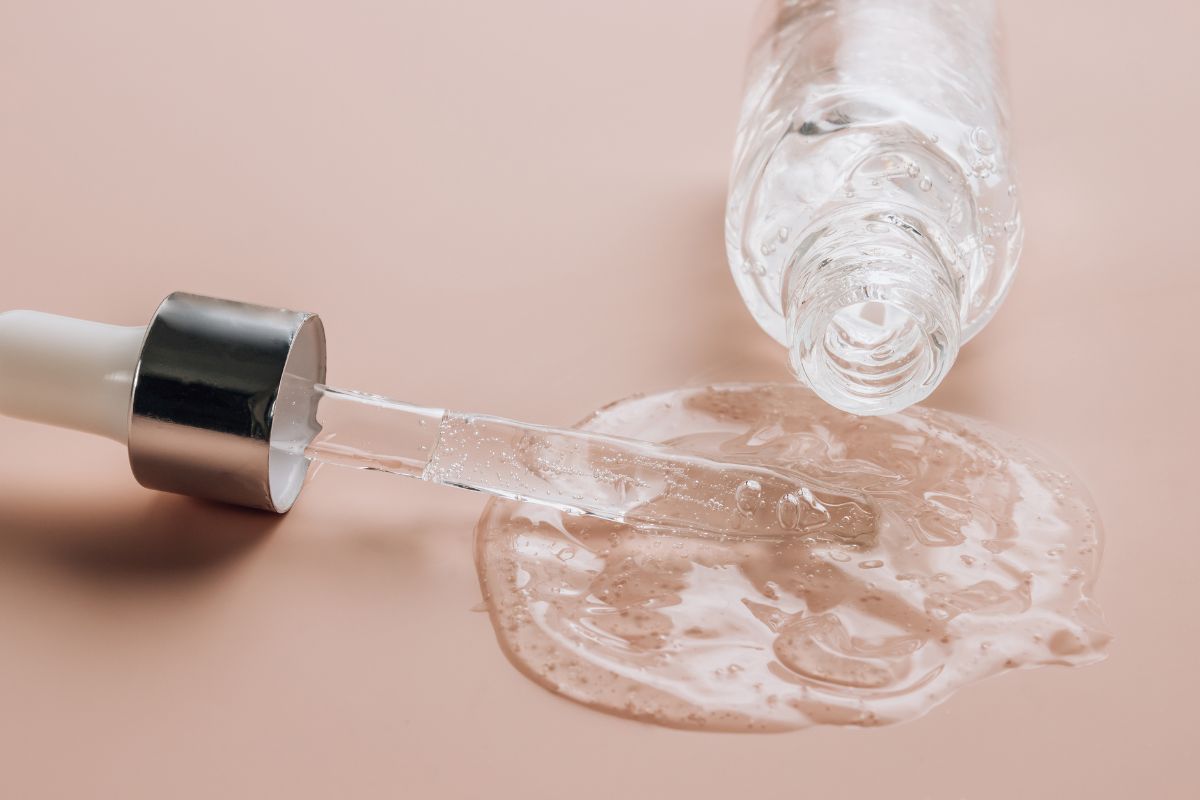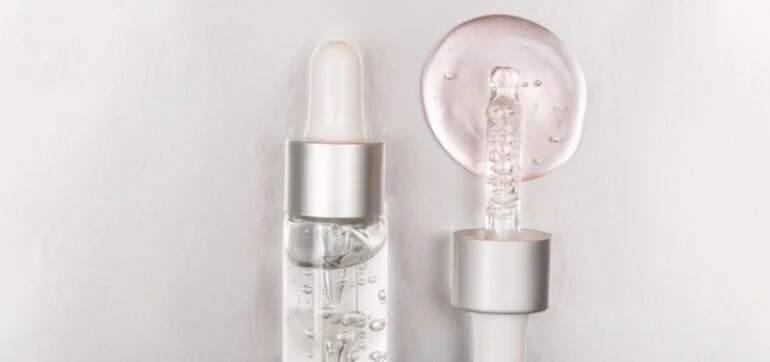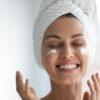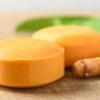When To Apply Retinol And Hyaluronic Acid For Maximum Results
- Posted on
 Corinne Grace
Corinne Grace- Categories: Skin Care

Have you ever felt overwhelmed by skin care choices? In the skincare world, two powerhouse ingredients often come up in conversation: hyaluronic acid and retinol. Both are celebrated for their transformative effects on the skin, but how do you choose what’s right for you?
In this article, we’ll explore these ingredients, mainly whether to use hyaluronic acid before or after retinol. We’ll look into their distinct benefits and offer advice on seamlessly incorporating them into your skincare routine for the best results.
What Is Hyaluronic Acid?
If you’re wondering—retinol or hyaluronic acid first? Let’s start with an overview of hyaluronic acid. Hyaluronic acid is naturally present in the body, mainly in the skin, connective tissues, and eyes. Its chief role is to hold water, keeping tissues lubricated and moist. This hydrating property makes it a popular skincare ingredient.
Hyaluronic acid can support up to 1,000 times its weight in water, effectively maintaining skin moisture levels. This helps reduce fine lines and wrinkles, giving a plump and youthful complexion. Due to its lubricating properties, hyaluronic acid is also used in medical applications like joint injections and eye surgeries. The versatility and effectiveness of hyaluronic acid make it valuable in health and beauty routines.

What Hyaluronic Acid Does For Your Skin And Its Benefits
Hyaluronic acid is a powerful ingredient widely recognized for its impressive skincare benefits. Here are some of the key advantages it offers for your skin:
- Deep Hydration. Hyaluronic acid can accommodate up to 1,000 times its weight in water, providing intense, long-lasting hydration. It’s great for dry or dehydrated skin. It helps maintain moisture levels all day.
- Plumping Effect. Hyaluronic acid excels at retaining moisture. It helps plump the skin and diminish fine lines and wrinkles, leading to a glowing, more youthful complexion with a natural glow.
- Improved Elasticity. Consistent application of hyaluronic acid can greatly improve skin elasticity. Over time, this leads to firmer skin. It becomes more resilient and youthful-looking. The signs of sagging and aging are effectively combated.
- Soothing Properties. Hyaluronic acid has anti-inflammatory properties. It can calm and soothe irritated or sensitive skin, making it an excellent choice for those dealing with redness, irritation, or conditions like rosacea.
- Compatibility with Other Ingredients. Hyaluronic acid is well-tolerated and integrates easily into various skincare routines. It complements retinol and vitamin C, amplifying their effects and delivering comprehensive skin benefits.
- Protective Barrier. Hyaluronic acid strengthens the skin’s natural barrier. It shields against environmental aggressors like pollution and UV rays. This defense helps prevent premature aging and promotes a healthier complexion.
Integrating hyaluronic acid into your skincare routine can produce more hydrated, smoother, radiant skin. This key ingredient is essential for anyone seeking to enhance their skin health.

When To Use Hyaluronic Acid In Your Skincare Routine
Hyaluronic acid is a versatile add-on to any skincare regimen, suitable for morning and evening use. For the best outcome, apply it after cleansing and toning. Use it before moisturizing. This step helps draw moisture into the skin more effectively.
In the morning, hyaluronic acid keeps your skin hydrated throughout the day, delivering a plump and youthful glow. It supports the skin’s natural repair process at night, ensuring you wake up with a refreshed and radiant complexion. Pair it with a high-quality moisturizer to seal in the hydration to maximize its benefits.
What Is Retinol?
Retinol, a vitamin A derivative, is a gold-standard ingredient in anti-aging skincare. It boosts cell turnover and collagen production and reduces fine lines, wrinkles, and hyperpigmentation. Retinol enhances texture and tone for a youthful appearance by promoting new skin cells. It also unclogs pores, benefiting acne-prone skin. Dermatologists suggest starting with a low concentration to minimize irritation. Steadily increase usage as your skin builds tolerance.
Can Hyaluronic Acid And Retinol Be Used Together?
Hyaluronic acid and retinol can be applied in tandem, complementing each other exceptionally well. Hyaluronic acid’s hydrating properties can counteract the drying effects of retinol. Together, they help achieve smoother, more hydrated, and youthful-looking skin. For the main concern—should I apply hyaluronic acid before or after retinol? Let’s take a closer look at the steps on using hyaluronic acid and retinol next.

Proper Way To Combine Hyaluronic Acid And Retinol
To make the most out of using hyaluronic acid and retinol together, follow these steps:
1. Wash Your Face
Start by cleansing your face with a gentle cleanser to remove dirt, oil, and makeup. This step preps your skin to soak up the following products better. A gentle cleanser is crucial to avoid stripping away natural oils, which can cause irritation.
2. Dry Off Your Skin
After washing your face, lightly pat your skin with a clean towel to avoid irritation. Your skin must dry fully before applying retinol, as dampness can heighten the risk of irritation. Allow a few moments for your skin to air dry entirely if needed.
3. Apply Your Retinol
Apply a pea-sized amount of retinol to your face, concentrating on areas with fine lines, wrinkles, or hyperpigmentation. Exercise caution around sensitive zones like the eyes and mouth. If this is your first time trying retinol, start with a lower concentration and gradually increase as your skin establishes tolerance. This potent ingredient boosts skin cell turnover, promoting a youthful appearance.
4. Apply Your Hyaluronic Acid
Once the retinol has been fully absorbed into your skin, follow with a hyaluronic acid serum. This step helps to hydrate and plump the skin, mitigating any potential dryness caused by the retinol. As a humectant, hyaluronic acid soaks up moisture from the environment into the skin, making it an ideal complement to retinol.
5. Don’t Forget The Moisturizer
Apply a quality moisturizer as the final step to lock in all previous layers and provide an extra hydration barrier. Select a moisturizer tailored to your skin type—oily, combination, or dry. This crucial step helps seal the benefits of retinol and hyaluronic acid, ensuring your skin remains hydrated and balanced.
Follow these steps to integrate hyaluronic acid and retinol into your skincare routine. This will maximize their benefits and minimize potential irritation.
Tips To Get The Most Of Hyaluronic Acid And Retinol
Add hyaluronic acid to your skincare regimen and include retinol. These ingredients can significantly enhance their effectiveness. Here are some tips to maximize their benefits and achieve radiant, youthful skin.
- Introduce slowly. If you’re new to retinol, apply it once or twice a week to let your skin adjust. Steadily level up the frequency as your skin builds tolerance, aiming for nightly use.
- Use sunscreen. Retinol can make your skin highly sensitive to the sun, increasing the risk of damage. To shield your skin from the damaging sun’s UV rays, use a broad-spectrum sunscreen. Look for a product that has a minimum SPF of 30. Apply it during the day, especially if you use retinol at night.
- Hydrate. Drink plenty of water to support your skin’s hydration levels from within. Using topical hyaluronic acid helps maintain your skin’s moisture barrier. Staying well-hydrated also keeps your skin plump and supple.
- Avoid harsh products. Avoid using potent active ingredients like AHAs or BHAs with retinol to prevent irritation. Instead, choose gentle, hydrating products. These will complement the effects of retinol and hyaluronic acid.
Follow these steps to put to good use the benefits of hyaluronic acid and retinol. This will result in a brighter and more youthful complexion. Remember, consistency and patience are crucial in any skincare routine.
Frequently Asked Questions About Hyaluronic Acid And Retinol Combination
Should I apply retinol before or after moisturizer?
Apply retinol before your moisturizer. A typical skincare routine starts with the lightest products and progresses to the heaviest. Applying retinol first ensures it penetrates the skin more effectively. After applying retinol, using a moisturizer helps to lock in the retinol and minimize any potential irritation or dryness.
Should I apply retinol before or after serum?
You should apply retinol after your serum. Serums have many active ingredients. They’re made to be used early in a skincare routine. Applying retinol after your serum ensures that both products can work without issues.
What is the best way to use retinol and hyaluronic acid in your nighttime routine?
The skin does most of its repair work overnight, so retinol-based products are ideal for use at night. After cleansing, apply retinol, followed by a hyaluronic acid serum. Finish with a moisturizer to minimize any potential discomfort or dryness.
How long should you wait between applying retinol and moisturizer?
To ensure your retinol remains effective, allow it to fully absorb into your skin for up to 10 minutes before applying moisturizer. This prevents the moisturizer from diluting the retinol and helps maximize its potency.

Achieve Radiant, Youthful Skin With Hyaluronic Acid And Retinol
By now, you know the answer to the question—should I apply hyaluronic acid before or after retinol? Hyaluronic acid and retinol offer great benefits for the skin. They provide deep hydration and anti-aging effects. They can enhance your skincare routine, creating a radiant and youthful complexion. By following the proper application steps and tips, you can make the most of the benefits of these potent components. Ready to transform your skin? Start incorporating hyaluronic acid and retinol into your regimen today!
Corinne Grace
Meet Corinne Grace, a passionate writer for AMVital.com. I create articles based on sound scientific evidence to help you make healthy decisions. My journey in both the medical and writing fields has equipped me with a unique perspective. As a nurse, I've been on the front lines, seeing the critical importance of accurate information in healthcare. My goal is to demystify complex medical concepts and present them in a way that's accessible and engaging. Let's navigate the path to better health together!
all author posts




